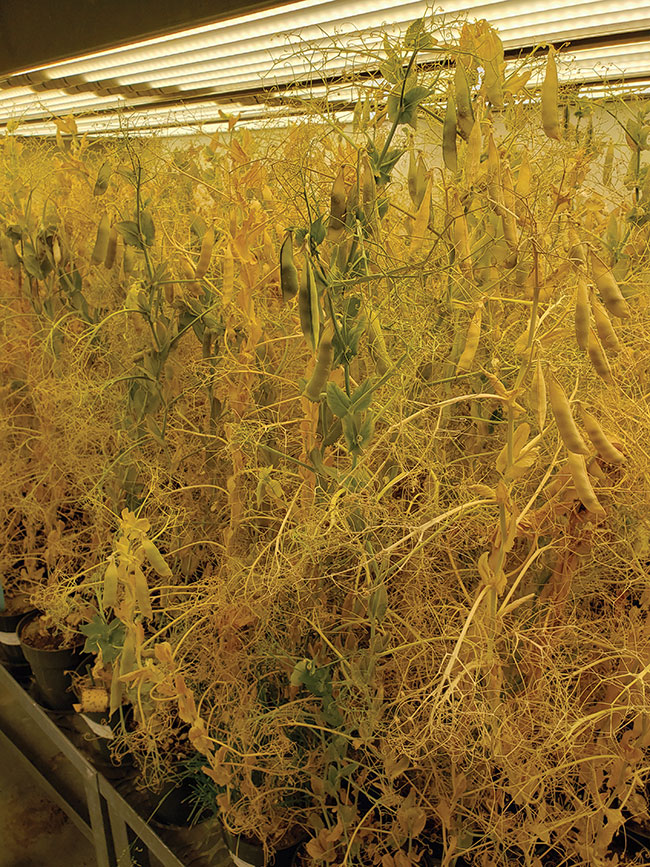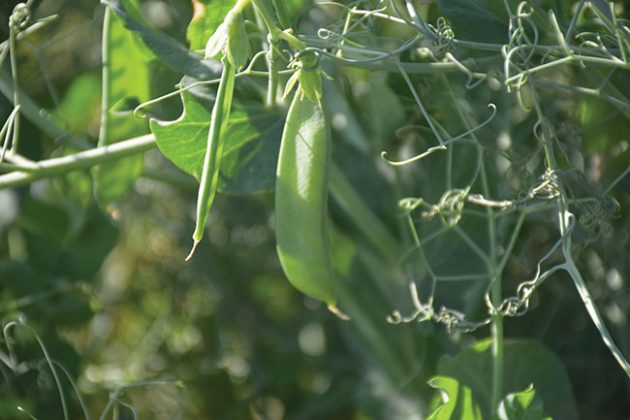
Features
Agronomy
Pulses
Examining micronutrients on pea
A new study assesses the protein and yield response of yellow pea cultivars to micronutrient fertilization.
September 26, 2022 By Donna Fleury
 A controlled environment study is assessing the impact of
micronutrient fertilization on grain yield and quality of two yellow field pea cultivars.
Photo courtesy of Jeff Schoenau.
A controlled environment study is assessing the impact of
micronutrient fertilization on grain yield and quality of two yellow field pea cultivars.
Photo courtesy of Jeff Schoenau. For field pea production, crop yield and protein content are important. Concentrations of certain micronutrient elements in the grain, such as iron and zinc, are very important for human nutrition and health. However, the nature of soil micronutrient availability and interactions with field pea production and quality in Western Canada are not well understood. To date, limited research is available on the impact of fertilization with multiple micronutrients.
“The growing demand for top-yielding field pea production with high protein content and other quality attributes makes understanding the relationship of soil micronutrients to pea production very important,” says Jeff Schoenau, professor of soil science and Saskatchewan Ministry of Agriculture Soil Nutrient Management Chair at the University of Saskatchewan (USask). “We have some previous research assessing soil and foliar applications of zinc and related yield responses in pea, but have not looked at the quality aspect before in Prairie soils, specifically protein and micronutrient content of grain. Micronutrients are involved in many plant processes that affect plant yield and quality, such as enzymes, proteins, growth hormones, reproduction, N2-fixation, and others. However, little is known regarding the interaction and impact of important micronutrients including copper (Cu), zinc (Zn), iron (Fe), boron (B), and molybdenum (Mo) fertilization on both yield and quality.”
Schoenau and his USask colleagues, Ryan Hangs of the department of soil science, and Tom Warkentin of the Crop Development Centre, are examining the impact of micronutrient fertilization on grain yield and quality of two yellow field pea cultivars in a new three-year project.
“Our first objective was to determine the potential of seeing a response of pea with multiple micronutrients on a wide range of soils, and therefore we chose to conduct the study in a controlled environment,” Schoenau explains. “We collected several potentially micronutrient-deficient soils from commercial fields in Saskatchewan for the study. Soils that are more likely to have micronutrient deficiencies tend to be sandy soils very low in organic matter and of high pH, especially in the Gray soil-climatic zone, as well as organic, peaty soils and eroded portions of fields. In this study we collected soils from agriculture fields formed under both forest and grassland where deficiency was suspected and soil supplies were low.”
For the study, two yellow pea cultivars – CDC Inca and CDC Spectrum – were seeded and grown to maturity under controlled environment conditions. The micronutrient fertilizer treatments included an unamended control and six banded treatments of CuSO4, ZnSO4 and FeSO4 applied at a rate of 5 kg nutrient/ha,
boric acid and molybdate at a rate of one kg nutrient per hectare and the final treatment including all micronutrients combined. Nitrogen, phosphorus, potassium and sulphur fertilizers were applied at recommended rates to prevent any macronutrient deficiencies.
“By doing the experiments in a controlled environment setting, the environmental conditions are optimized for plant growth and equalized compared to the field, where small soil, temperature and moisture variations can add to variability and cause micronutrient deficiencies to appear and disappear,” Schoenau says. “Overall in these experiments, possibly related to warm temperature and moist soil conditions that favour micronutrient mobilization, we did not see large responses of pea grain yield to micronutrient fertilization. Of the micronutrients evaluated, a response to zinc and copper fertilization seems most likely, including both positive and negative effects. The grain yield responses of the two cultivars CDC Inca and CDC Spectrum were similar, with few consistent differences. We may see more micronutrient interactions impacting plant uptake once we have completed the grain and straw tissue analyses.”
“We did find some interesting results with one of the soils from south-central Saskatchewan. The soil was a Kettlehut association solidized solonetz of lower organic matter, high bulk density and generally a poorly structured soil with low soil concentrations and supply rates of available zinc and copper,” adds Schoenau. “The yield of both cultivars appeared to benefit from the addition of zinc and copper on this soil. The poor structure and high density that limits nutrient movement and root growth were likely contributing factors to the response. Peas grown on this soil were also affected by root disease and therefore increased the potential for a response to micronutrient additions, such as copper and zinc, that tend to be immobile. These are the kind of conditions where the greatest likelihood of a yield response to micronutrients can be expected.”
For one soil, the Dorintosh soil, the greatest pea yields were in the control treatment with no micronutrient added, and in the treatments with no copper or zinc added, compared with the treatment receiving all micronutrients. Schoenau notes that this possibly indicates copper and zinc toxicity effects and/or these micronutrients may be impacting the uptake of other essential nutrients. In another soil, Loon River association, the elimination of boron caused a significant yield reduction in the CDC Inca cultivar.
The project is moving into the second phase of the research that will concentrate on the impacts of fertilization on the content of protein, zinc, iron and phytate in the grain. These micronutrients in particular contribute to the human nutritional value and marketability of the pea grain.

The second phase of this research project will focus on how fertilization affects the protein, zinc, iron and phytate content in the grain.
Photo by Stefanie Croley.
“In collaboration with Tom Warkentin’s research lab, we will be measuring the protein content as well as the zinc and iron concentrations as a result of the fertilization treatments,” Schoenau explains. “As part of the quality impacts of the treatments, the phytate:zinc:iron molar ratios will be determined in the grain. A high phytate:metal ratio indicates lower human bioavailability of that micronutrient metal. Phytate is an antinutritional compound that can bind of some of the micronutrient metals and lower the bioavailability for humans. We want to determine if micronutrient fertilization can decrease the ratio and increase the bioavailability of zinc and iron in the grain.”
It can be very difficult for both researchers and growers to predict if there will be a response to micronutrient application. “Although we sometimes observe trends in research data, it is often challenging to come up with a statistically significant response due to the inherent variability and uncertainty in the affecting factors,” Schoenau says. “I like to refer to micronutrient deficiencies as kind of ghost-like in nature as they can appear and disappear depending on the conditions. Many plant, soil and environmental factors interact in a complex manner to influence whether a micronutrient deficiency will appear or not, including environmental factors such as temperature and moisture, and other factors such as soil conditions, root growth and disease. Therefore, using multiple assessment tools such as soil tests in combination with tissue tests, along with having some test strips across a field, can be valuable in determining presence of micronutrient limitations Knowing where to look is important as well. Micronutrient availability can vary widely across fields, so deficiencies tend to occur in patches and localized areas such as eroded knolls and sandy areas, and potentially only these areas within the field may require an application of micronutrient fertilizer.”
Schoenau adds that previous research has shown that both soil and foliar applications can be effective for many of the micronutrients. The timing of application is important, depending on the micronutrient. Foliar applications are generally applied at low rates of about one lb/acre or less, so their effect is mainly in the year of application with limited residual carryover to following seasons. Soil applications are usually made at higher rates that can have a benefit not only for the current crop, but also for crops that follow in rotation.
“So far, we have completed the first phase of the project with determination of yield response,” Schoenau adds. “We are now moving into the second phase of the project and expect to complete the assessment of protein, phytate and micronutrient concentrations in the harvested grain over the fall and winter. Our final results should be available early next spring.”